In the surrounding area
BEACHES IN TUSCAN MAREMMA
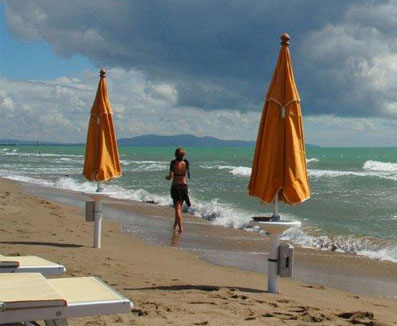 160 km of coast, made up of a multitude of landscapes, is bathed by the sea of the Maremma, one of the cleanest in Italy. Long stretches of fine sandy beaches alternate with bluffs jutting out over the sea, wild, magical little bays, private beach clubs, public beaches, picturesque islets, seaside towns, tourist havens and fascinating seabeds.
160 km of coast, made up of a multitude of landscapes, is bathed by the sea of the Maremma, one of the cleanest in Italy. Long stretches of fine sandy beaches alternate with bluffs jutting out over the sea, wild, magical little bays, private beach clubs, public beaches, picturesque islets, seaside towns, tourist havens and fascinating seabeds.
Castiglione della Pescaia beach sits right in front of the town and is a sandy beach (private and public) with shallow waters, stretching out from the foot of the Aragonese castle across to the Baia delle Rocchette protected by a little promontory upon which the castle is perched. This last section is known as Le Rocchette beach. South of the river there are 5 kilometres of public beach popular with kite-surf enthusiasts. The beaches of Punta Ala can also be easily reached from Castiglione della Pescaia by hiring small boats or dinghies from the town boatyard and its seashore consists of a tiny beach to the left of the port and a sandy beach several kilometres long, not too large and entirely sheltered by the pine forest. There are also daily ferry crossings from Castiglione della Pescaia port to Giglio. Daily ferry crossings depart from Piombino to Elba.
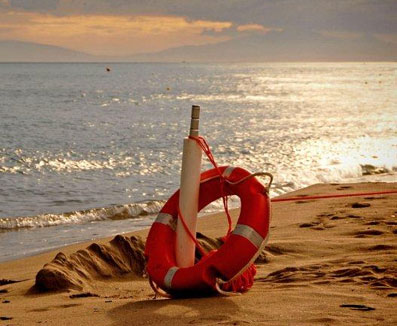 South of Castiglione della Pescaia is the often windswept Talamone beach, which makes it just the place for sail-powered sports (kitesurfing, windsurfing). The picturesque cove below the fortress, surrounded by wild vegetation, is known as the “Bagno delle donne” with a pebble beach flanked by a bluff and a very interesting seabed.
South of Castiglione della Pescaia is the often windswept Talamone beach, which makes it just the place for sail-powered sports (kitesurfing, windsurfing). The picturesque cove below the fortress, surrounded by wild vegetation, is known as the “Bagno delle donne” with a pebble beach flanked by a bluff and a very interesting seabed.
With its lagoon and Giannella and Feniglia beaches, two sandy beaches with private beach clubs and long stretches of public beach, Orbetello looks out from the foot of the Argentario promontory. Feniglia beach sits in front of a nature reserve, splendid coastal pine forest, which can be walked or cycled entirely and where it’s not a rare occurrence to run across deer. Continuing southwards we come to the splendid, towering Argentario promontory which is home to the towns of Porto Ercole and Porto Santo Stefano.You can hire a dinghy or boat and sail around the promontory to be amazed by the many coves that you come across (each more beautiful than the last).
And here is the splendid, towering Argentario promontory, home to the towns of Porto Ercole and Porto Santo Stefano. You can hire a dinghy or boat and sail around the promontory to be amazed by the many coves that you come across (each more beautiful than the last).
Next we encounter the small Ansedonia promontory and its fine sandy beach. Ansedonia Beach has some private beach clubs with bar and restaurant overlooking the sea but most of the beaches are public. Off the coast of Ansedonia we find the tiny marine reserve of Giannutri famous for the rare beauty of its seabed, a real paradise for divers and keen snorkellers.
OTHER SITES
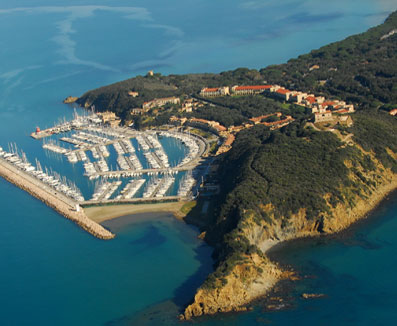
Punta Ala, the Tuscan archipelago, the Argentario Promontory, Vetulonia and its Etruscan tombs, Massa Marittima, Montalcino, Saturnia and its famous thermal spas, Pitigliano and the tuff towns, the wild natural beauty of the Diaccia Botrona marshland and the Parco dell’Uccellina Regional Park.
They are all splendid places within easy reach from hotel C’era una volta in Castiglione della Pescaia.
Punta Ala is a famous seaside resort, annexed to the town of Castiglione della Pescaia in the province of Grosseto. The place that took the name of Punta Troia was then changed on from the great Italian aviator Italo Balbo, who had purchased some fortifications and houses in the area and then became its residences, to change its name in Punta Ala, taking its cue from aeronautical jargon. This current centre of tourism has been developing during the twentieth century, especially during the’70s.
Saturnia is located just a short distance away from the famous thermal springs and blends in perfectly with the Maremma area’s typical, gently rolling hills.
It is the ideal starting point for trips to the surrounding area, with both the sea and Monte Amiata within a 50 minute car driving. Despite its small size, the village offers a wide range of restaurants and accommodation, as well as a good selection of typical local products.
It is naturally also one of the most suitable places for those who wish to stay at a short distance from the Spa and make use of the thermal baths, without staying inside the establishment itself. Saturnia also has its own attractive, romantic castle, although it is private property… However, you can console yourselves by visiting the adjacent Porta Romana, with relative Roman road, and the Piazzale Bagno Secco.
Sovana is a little village in the Maremma region, located on a spur of tuff, still preserving its ancient medieval aspect. The origins of Sovana (formerly Suana) date back to very ancient times. The presence of many remarkable monuments and vestiges of the past is evidence of the ancient splendours of the Etruscans, of the Papal State and of the Aldobrandeschi family.
The first built-up area dates back to the Bronze Age, later on in VII century BC.
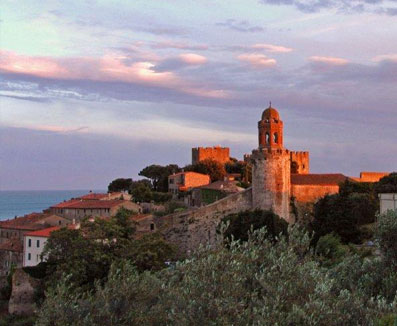 Pitigliano is a picturesque little village of Maremma located on a spur of tufa, falling sheer to green valleys on three sides. As you come closer to the town you are caught by a breathtaking view of unique beauty, while an imposing arch aqueduct constructed by Medici family welcomes in all its majesty. In Pitigliano you can still admire traces of the old ancestors who inhabited this place thousands years ago
Pitigliano is a picturesque little village of Maremma located on a spur of tufa, falling sheer to green valleys on three sides. As you come closer to the town you are caught by a breathtaking view of unique beauty, while an imposing arch aqueduct constructed by Medici family welcomes in all its majesty. In Pitigliano you can still admire traces of the old ancestors who inhabited this place thousands years ago
Sorano is a picturesque medieval village,located on a speer tuff spur surrounded by a flourishing and unspoiled wood vegetation. This very special position gives visitors the opportunity to walk through the village and admire unexpected and beautiful landscapes as they look over the cliff.
Sorano has preserved its typical medieval architectural structure, so you can still findwhere tortuous alleys, narrow streets, courtyards, portals and cellars dug into the tuff. On the top of the tuff the imposing Orsini fortress represents one of the most important preserved examples of military architecture in Maremma. Let us remind you that in the surrounding areas there are many archaeological sites which testify to the ancient presence of Etruscans.
Natural Park of Maremma, surrounded by marshes, pine woods, cultivated fields and grazing lands.
The Park area, delimited by the railway line Livorno-Roma, stretches along the Tyrrhenian coast from Principina a Mare to Alberese, and up to Talamone. The Park is characterized by important geographical elements such as the last stretch of the river Ombrone, the orographic system of the mountains of the Uccellina which reaches 417 meters of height in Poggio Lecci, the marsh area of the Trappola, and the coast which is both sandy and characterized by steep cliffs.
ARCHAEOLOGICAL MUSEUM ISIDORO FALCHI
THE LONG HISTORY OF VETULONIA
In the main square in Vetulonia, a hamlet of Castiglione della Pescaia and the main archaeological site of the Maremma, the Museo Civico Archeologico “Isidoro Falchi” boasts an incredible collection of artifacts covering nine centuries of history and splendor of the city, from its foundation in the ninth century BC until his death, at the end of the Roman period, around the fifth century A.D.
THE PLAQUE OF AUVELE FELUSKE
Among the artifacts found in the necropolis, including a huge amount of tiaras, jewelry and votive objects, stands the gravestone of oriental local prince Auvele Feluske, dating from the eighth or seventh century BC and regarded as the most important find of the Civic Archaeological Museum “Isidoro Falchi”.
VII THE CENTURY: THE SPLENDOR OF VETULONIA
The seventh century was the time when Vetulonia reached the height of its splendor and the Museum testifies to the helmets with gold and bronze necklaces and crowns. From this period dates also the “Stone of Dupiane” who, perhaps from the tomb of a master, is a rare and valuable example of Etruscan alphabet, similar to the ancient greek.
KNOW THE ETRUSCANS
Among the enormity of exhibits in the Museo Civico Archeologico “Isidoro Falchi”, that tell us much about the Etruscans and the origins of the Maremma, there are also coins, pottery, jewelry, statues and tombs reconstructions with the original burial goods in them found. Also very valuable in the terracotta bas-relief that adorned the entrance of an aristocratic house, the “Domus of Medea”, depicting scenes from the greek myth of the Golden Fleece.
TIMETABLES
From October to February: 10:00 to 16:00
March to May: 10:00 to 18:00
From June to September: 10:00 to 14:00 4:00 p.m. to 8:00 p.m.
TICKETS AND CONTACTS
Full price: € 5.00
Reduced and groups min. 20 pp: € 2.50;
School groups: 1.00 €
For information:
Civic Archaeological Museum “Isidoro Falchi” – Piazza Vetluna 1 – Vetulonia
Tel. 0564-948058
museovetulonia@libero.it
www.comunecdp.it
THE PARKS
NATURE RESERVE DIACCIA BOTRONA
Nature Reserve Diaccia Botrona, about 1000 hectares between Castiglione della Pescaia and Grosseto, is what remains of the ancient lake that in Etruscan times was the “Lacus Prilius” and that until the ‘700 covered the area, dried up to fight malaria .
DIACCIA BOTRONA: A RESOURCE FOR BIODIVERSITY
Protected area since 1971, the reserve Diaccia Botrona is now a habitat for around 200 different animal species. To name just a few, you will come across a myriad of migratory birds like flamingos, osprey, red and white herons herons, kites or European rollers. In terrestrial and marsh tortoises, wild animals such as foxes, porcupines, badgers or hedgehogs.
THE FLORA OF THE SWAMP
It enters the Nature Reserve Diaccia Botrona with a distance of 16 km or a much shorter path of about 2 km, but in the summer you can also make trips barca.La marsh and the extensive green area that touches offer an incredible show of colors and scents, among the tamarisk, elm trees, rushes, straws and various orchid species, some very rare.
ISLAND CLODIA
Clodia on the hill which dominates one end of the swamp, are the ruins of the ancient abbey of San Pancrazio al Fango, built in the twelfth century on the remains of a luxurious Roman villa that the senator will Clodius built in imperial times.
XIMENES HOUSE
At the entrance of Diaccia Botrona one is struck by a two-storey building that surmounts the marsh, a deep red color. It is the “Casa Ximenes”, named after the Jesuit monaco, who designed it in 1765 to liberate the area from malaria. The house, for its particular position, would have had to split seawater and freshwater, thus defeating the deadly fever caused, according to monaco, by this insane mixture of the two waters. It did not work, causing him to fall out of favor but the house he built is a useful tool today to protect the delicate ecosystem of the marsh reserve, as well as an interesting multimedia museum.
MALARIA
Malaria has plagued the area for centuries, as to be at the center of many legends. The most famous identifying it with a witch from burning eyes who lived the Diaccia Botrona marsh and it was able to burn the people with a look, terrorizing the inhabitants of Castiglione della Pescaia.
OPENING TIME
Visitor Center Casa Ximenes
From June to August: every day, except Monday 16.00-22.00
From September to May: from Thursday to Sunday 13:00 to 7:00 p.m.
On request: guided tours by boat in the swamp
Contacts
Province of Grosseto, the field of Nature Conservation (tel 484 581 0564)
Visitor Center Casa Ximenes (tel 347 5345189-339 4331553)
HOW TO GET TO THE NATURE RESERVE DIACCIA BOTRONA
You get to Castiglione della Pescaia from the provincial road SP 158 Collacchie. On entering the village, before the bridge Giorgini, turn right to the Casa Ximenes.
Alternatively, from the main road in the direction of Castiglionese Castiglione della Pescaia you get to Badia Bridges. From here you enter the Diaccia Reserve Botrona by a path that runs alongside the road, on the left.
NATURAL PARK MAREMMA
THE LUNG MAREMMA
green heart of the area, the Natural Park of Maremma, the Tuscan familiarly call the “Uccellina” (by limestone mountains that dominate the south central part) covers nearly 10,000 hectares and ranges from Principina a Mare (about 20 km south of Castiglione della Pescaia) to the Talamone promontory.
Established as a nature park with a Regional Law in 1975, the Natural Park of Maremma insists on common Grosseto, Magliano in Toscana and Orbetello, and is one of the scenic treasures of Tuscany.
Inside it boasts dense forests, historical artifacts, pristine beaches and huge pastures, as well as a farm owned by the Region of Tuscany, the “Granary Lorraine”, home of the “Fodazione Slow Food for Biodiversity” made entirely from local materials recovery.
WHERE THERE NATURE REIGNS SUPREME
From the marshlands of the “swamp the trap”, among which reeds inhabit many species of ducks and migratory, we move on to the granite cliffs covered by thick Mediterranean myrtle, strawberry tree and mastic, including peep of rare dwarf palms . The part of the Monti dell’Uccellina is instead covered with centuries-old evergreen forests, inhabited by foxes, wild cats, deer and porcupines. Finally, inside the Maremma Natural Park it is common to find herds of cattle in the wild Maremma, grazed by the famous “cowboys”.
ROUTES OF THE PARK NATURE, HISTORY AND TASTE
Visits to the Park are possible along many routes leading to the discovery of the many beauties of the Maremma Natural Park.
16 are the routes on foot, by bike 4, 4 horse, carriage 4, 2 and 1 canoe at night. In addition, in collaboration with Slow Food, they are organized also several wine tasting tours to discover local organic products.
Among the routes, one of the most known will take the Abbey of San Rabano, a Romanesque abbey founded by the Benedictines in the XI century, and of which there are now some well-preserved parts.
A second route is the one that runs along the steep cliffs to discover ancient towers that from Castiglione della Pescaia Talamone needed to prevent pirate attacks.
Others allow you to get to the wild beach of Marina di Alberese or the magnificent cove of Cala di Forno, with its crystal clear waters and the beach crescent-shaped, always enjoying the incredible views that the park throws the Tuscan Archipelago and on a stretch Tirreno from blue clearer.
HOW TO GET TO THE REGIONAL PARK OF MAREMMA
To arrive at the main entrance of Grosseto, where the Visitor Center, the SS1 Aurelia, about 7 Km from Grosseto, take the Rispescia / Alberese / output of the Maremma Natural Park and follow the signs to the entrance to the Park.
CONTACT CENTER VISITS REGIONAL PARK AUTHORITY OF MAREMMA
For information on times and how to visit:
www.parco-maremma.it – info@parco-maremma.it
0564/393211
WWF OASIS BURANO LAKE
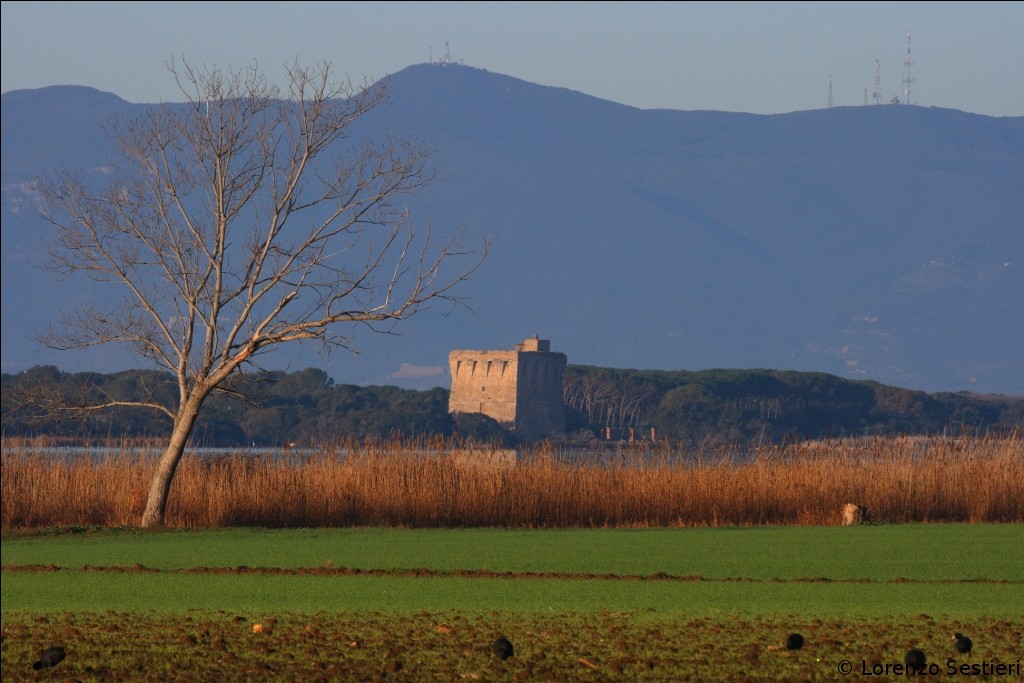
THE LAKE AND THE DUNES
The Reserve of Lake Burano, known also as a Zone of International Importance under the Ramsar Convention, was established in 1980 and is managed by the WWF.
The lake of Burano is a coastal lake survived an ancient lake at the southern end of the Maremma in the municipality of Capalbio. It is separated from the Tyrrhenian Sea by a narrow strip of dunes, which is one of the best preserved coastlines in the region. It covers about 410 hectares between Ansedonia and Capalbio including 140 occupied by an average of one meter deep lake.
In 2005, both the Lake Burano that the dune of Lake Burano were listed as sites of interest by the Ministry of the Environment.
Supervises the lake Tower Buranaccio built around the mid-sixteenth century, the southernmost defensive outpost of the State of the Garrisons, at the border with the Grand Duchy of Tuscany and the Papal State.
AN UNFORGETTABLE JOURNEY
Lake Burano is an example of how the Maremma is able to offer unique and wonderful landscapes, while protecting the environment.
The tours of the reserve are organized by WWF through a path with watchtowers and huts observers, a nature trail, butterfly garden and observatory for night vision in mammals.
The path on the flat, about two kilometers long, enables visits to people with disabilities.
On the long beach, enchanted by the sparkle of the waters that reach the sand you walk into a magical world populated by narcissus sea and santolina.
The Mediterranean vegetation dominates the area beyond the dunes of juniper bushes, juniper, myrtle, mastic tree and cork oak.
The reeds and the water lily and many other species typical of wetlands surrounding the lake shore.
Similarly surprising variety of animals and wild birds: tufted ducks, herons, flamingos, the marsh harrier, harriers, ospreys and Lanner. Among the mammals in the sandy dunes and scrub live porcupines, badgers, foxes, weasels, marten and the skunk.
In this pristine environment it plays the monarch butterfly, the sphinx dead head and Lelya Cenosa, a small moth whose caterpillar feeds on marsh reed.
HOW TO GET THE OASIS BURANO LAKE
From Alberese take the S.S. Aurelia towards Rome and follow the directions for Capalbio, continue taking the junction for Marina di Capalbio at Km 133
Oasis is open from September to April,
visits on Sunday at 10.00 and at 14.30 (15:00 daylight saving time).
Groups and schools every day, by reservation.
The departure of all visits, unless otherwise indicated is always from the Oasis Visitor Center S.P. Seaside, 35 Capalbio
For photographers and birders, it is possible, in certain periods, to provide access to particular times, agreeing with management.
ABOUT
Contacts and information tel. +39 0564 898829
e-mail: lagodiburano@wwf.it
http://www.wwf.it/oasi/toscana/lago_di_burano/


